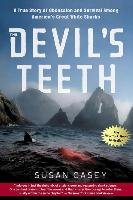A journalist's obsession brings her to a remote island off the California coast, home to the world's most mysterious and fearsome predators--and the strange band of surfer-scientists who follow them
Susan Casey was in her living room when she first saw the great white sharks of the Farallon Islands, their dark fins swirling around a small motorboat in a documentary. These sharks were the alphas among alphas, some longer than twenty feet, and there were too many to count; even more incredible, this congregation was taking place just twenty-seven miles off the coast of San Francisco.
In a matter of months, Casey was being hoisted out of the early-winter swells on a crane, up a cliff face to the barren surface of Southeast Farallon Island-dubbed by sailors in the 1850s the "devil's teeth." There she joined Scot Anderson and Peter Pyle, the two biologists who bunk down during shark season each fall in the island's one habitable building, a haunted, 135-year-old house spackled with lichen and gull guano. Two days later, she got her first glimpse of the famous, terrifying jaws up close and she was instantly hooked; her fascination soon yielded to obsession-and an invitation to return for a full season. But as Casey readied herself for the eight-week stint, she had no way of preparing for what she would find among the dangerous, forgotten islands that have banished every campaign for civilization in the past two hundred years.
The Devil's Teeth is a vivid dispatch from an otherworldly outpost, a story of crossing the boundary between society and an untamed place where humans are neither wanted nor needed.

